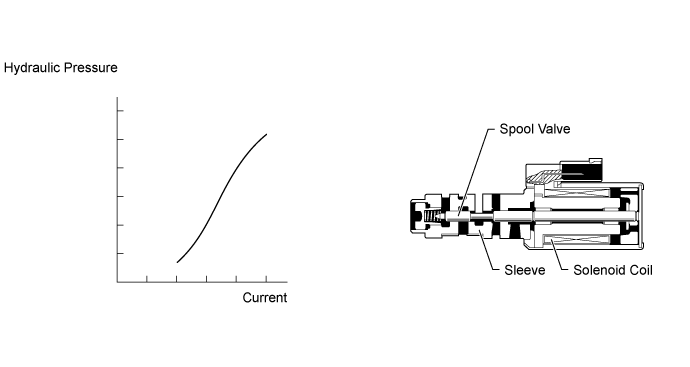Land Cruiser URJ200 URJ202 GRJ200 VDJ200 - A750F AUTOMATIC TRANSMISSION / TRANSAXLE
CHECK DTC OUTPUT (IN ADDITION TO DTC P2757)
INSPECT SHIFT SOLENOID VALVE SLU
INSPECT TRANSMISSION VALVE BODY ASSEMBLY
INSPECT TORQUE CONVERTER CLUTCH ASSEMBLY
DTC P2757 Torque Converter Clutch Pressure Control Solenoid Performance (Shift Solenoid Valve SLU)
DESCRIPTION
The ECM uses the signals from the throttle position sensor, air-flow meter, turbine (input) speed sensor, output speed sensor and crankshaft position sensor to monitor the engagement condition of the lock-up clutch.

Then the ECM compares the engagement condition of the lock-up clutch with the lock-up schedule in the ECM memory to detect mechanical problems with the shift solenoid valve SLU, valve body and torque converter clutch.
| DTC Code | DTC Detection Condition | Trouble Area |
| P2757 | Lock-up does not occur when driving in the lock-up range (normal driving at 80 km/h (50 mph)), or lock-up remains ON in the lock-up OFF range (2 trip detection logic). | Shift solenoid valve SLU remains open or closed Valve body is blocked Torque converter clutch Automatic transmission (clutch, brake or gear, etc.) Line pressure is too low |
MONITOR DESCRIPTION
Torque converter lock-up is controlled by the ECM based on the turbine (input) speed sensor NT, output speed sensor SP2, engine speed, engine load, engine temperature, vehicle speed, transmission temperature, and gear selection. The ECM determines the lock-up status of the torque converter by comparing the engine speed (NE) to the input turbine rpm (NT). The ECM calculates the actual transmission gear by comparing input turbine rpm (NT) to output shaft rpm (SP2). When conditions are appropriate, the ECM requests "lock-up" by applying control voltage to the shift solenoid SLU. When the shift solenoid SLU is turned on, it applies pressure to the lock-up relay valve and locks the torque converter clutch.
If the ECM detects no lock-up after lock-up has been requested or if it detects lock-up when it is not requested, the ECM interprets this as a fault in the shift solenoid valve SLU or lock-up system performance.
The ECM will turn on the MIL and store the DTC.
Example:
When either of the following is met, the system judges it as a malfunction.
(Engine speed is at least 70 rpm more than input turbine speed).
(The difference between engine speed and input turbine speed is less than 35 rpm).
INSPECTION PROCEDURE
| ACTIVE TEST |
- HINT:
- Using the intelligent tester to perform Active Tests allows relays, VSVs, actuators and other items to be operated without removing any parts. This non-intrusive functional inspection can be very useful because intermittent operation may be discovered before parts or wiring is disturbed. Performing Active Tests early in troubleshooting is one way to save diagnostic time. Data List information can be displayed while performing Active Tests.
Warm up the engine.
Turn the engine switch off.
Connect the intelligent tester to the DLC3.
Turn the engine switch on (IG).
Turn the intelligent tester on.
Enter the following menus: Powertrain / Engine and ECT / Active Test.
According to the display on the tester, perform the Active Test.
| Tester Display | Test Part | Control Range | Diagnostic Note |
| Activate the Lock Up | Control shift solenoid valve SLU to set automatic transmission to lock-up condition | ON or OFF | It is possible to check the shift solenoid valve SLU operation. [Vehicle Condition] The throttle valve opening angle is less than 35%. The vehicle speed is 80 km/h (50 mph) or more. |
- HINT:
Lightly depress the accelerator pedal and check that the engine speed does not change abruptly.

- HINT:
| 1.CHECK DTC OUTPUT (IN ADDITION TO DTC P2757) |
Connect the intelligent tester to the DLC3.
Turn the engine switch on (IG).
Turn the intelligent tester on.
Enter the following menus: Powertrain / Engine and ECT / DTC.
Read the DTCs using the tester.
| Result | Proceed to |
| Only P2757 is output | A |
| P2757 and other DTCs are output | B |
- HINT:
- If any other codes besides P2757 are output, perform troubleshooting for those DTCs first.
|
| ||||
| A | |
| 2.INSPECT SHIFT SOLENOID VALVE SLU |

Remove the shift solenoid valve SLU.
Measure the resistance according to the value(s) in the table below.
- Standard Resistance:
Tester Connection Condition Specified Condition 1 - 2 20°C (68°F) 5.0 to 5.6 Ω
Apply 12 V battery voltage to the shift solenoid valve and check that the valve moves and makes an operating noise.
- OK:
Measurement Condition Specified Condition Battery positive (+) with a 21 W bulb → Terminal 2Battery negative (-) → Terminal 1Valve moves and makes an operating noise
| *a | Component without harness connected (Shift Solenoid Valve SLU) |
|
| ||||
| OK | |
| 3.INSPECT TRANSMISSION VALVE BODY ASSEMBLY |
Check the transmission valve body assembly ().
- OK:
- There are no foreign objects on any valve.
|
| ||||
| OK | |
| 4.INSPECT TORQUE CONVERTER CLUTCH ASSEMBLY |
Check the torque converter clutch assembly ().
- OK:
- The torque converter clutch operates normally.
|
| ||||
| OK | ||
| ||